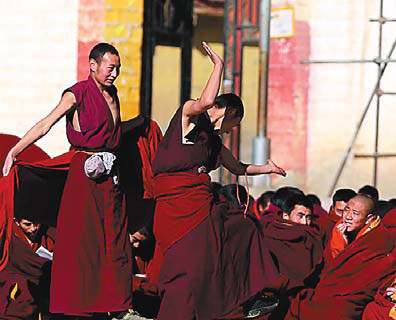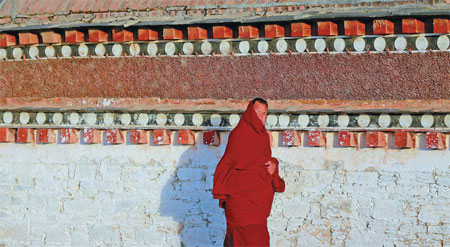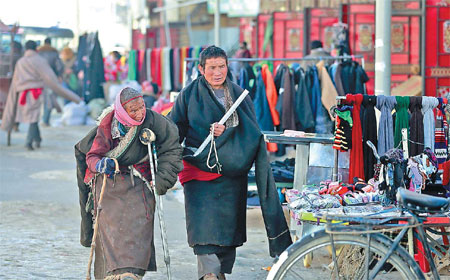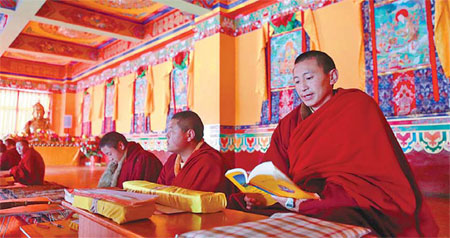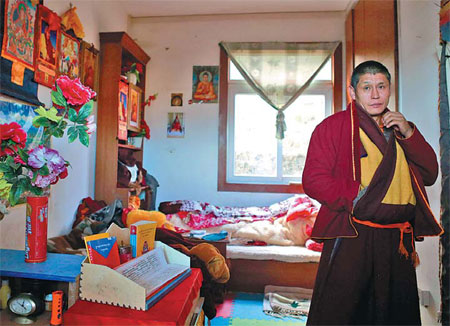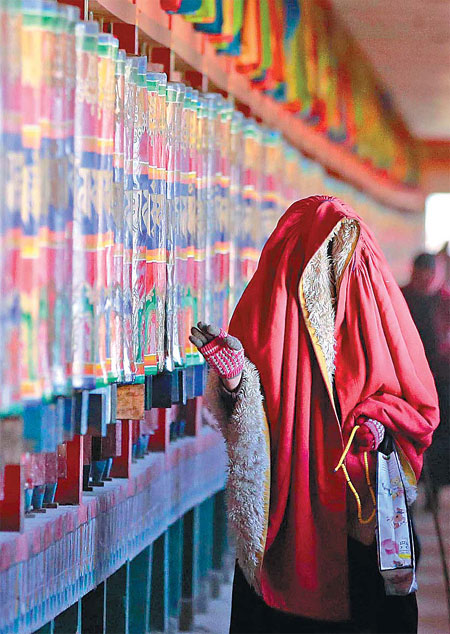Monks vent anger at self-immolation
Updated: 2012-12-21 07:05
By Cui Jia (China Daily)
|
||||||||
|
Monks discuss and debate various aspects of Buddhist teaching at Kirti Monastery in Aba county, Sichuan province. Feng Yongbin / China Daily |
|
A monk at Gomang Monastery in Aba county of Aba Tibetan and Qiang autonomous prefecture of Sichuan province. Photos by Feng Yongbin / China Daily |
|
Pedestrians on the busy Qiatangxi street, in Aba county of Aba prefecture. |
|
Monks chanting sutras in the Changlie Monastery in Barkam county, Aba prefecture. |
|
Asi, a 49-year-old monk, in his room in Changlie Monastery in Barkam county, Aba prefecture. |
|
A Tibetan woman spins the prayer wheels at Kirti Monastery. |
Fury at outside forces luring young men to gruesome fate, reports Cui Jia in Aba county, Sichuan province.
Carrying a large bottle of liquefied butter, Thangmokor walked slowly in his red robes - a distinguishing feature of Tibet's Buddhist monks - toward one of the halls of Kirti Monastery in the northwest of Aba county, Sichuan province. The elderly monk was on his way to refill the butter lamps in the halls so the flames could continue to burn as part of the daily rituals.
Outside a prayer hall, a monk threw hundreds of small pieces of paper inscribed with images of the Buddha into the blue sky, allowing the wind to lift the prayers higher. Yaks and sheep wandered freely through the courtyards. "Praying and studying Buddhism is what monks should do. Anything else is an interruption," said Thangmokor, who has spent the past 30 years at the monastery, which belongs to the Gelug sect, also known as the Yellow Hat sect of Tibetan Buddhism, and has a history stretching back more than 1,400 years.
As he passed through a residential area that encircles the main prayer halls, and houses more than 1,000 monks, Thangmokor paused outside one dwelling. He said he couldn't understand why Phuntsog, a young monk who used to live there, decided to commit self-immolation.
"People had never heard of this sort of thing until the last few years. After all, life is the most precious thing, isn't it?" he said.
Phuntsog was just 19 when he killed himself in 2011. According to an investigation conducted by the police after Tapey, a monk from the same monastery, set himself on fire on Feb 27, 2009 in Aba county, a unnamed foreign separatist group was portraying the young man as a hero to encourage more monks to self-immolate.
'Political goal'
"For the exiled 14th Dalai Lama and his group in India, instigating self-immolation is just a means of realizing their political goal of splitting Tibet from China," said Wang Chengxian, deputy Party secretary of the Aba Tibetan and Qiang autonomous prefecture. "About 80 acts of self-immolation have happened in Aba prefecture since 2009. Some people even refer to areas with a high number of self-immolations as 'hero counties'."
On Nov 26, 2011, the Dalai Lama told the BBC, "There is courage - very strong courage" in those who set themselves on fire. On Oct 19 last year, he presided over a dharma assembly, where he praised and supported the "brave and fearless" self-immolators and the leaders of the self-styled "Tibetan government-in-exile".
After what the police referred to as "brainwashing", Phuntsog, Tsering Tenzin and two other young monks from Kirti Monastery, who regarded Tapey as a hero, formed a group called "The Madmen's Gang". On March 2, Phuntsog and Tsering Tenzin, 22, decided to commit self-immolation. The other members offered to assist the pair by helping them buy petrol and perfumes to disguise the strong smell, according to the police.
Three days before Phuntsog set himself on fire on Qiatangxi street - Aba county's main commercial thoroughfare - on March 16, two members of the gang revealed the plan and sent photos of Phuntsog and the group to a contact abroad via QQ, a popular Chinese instant-messaging service, ready for publication after the event. One of the photos of Phuntsog was later used in media reports abroad.
After witnessing Phuntsog's self-immolation, Tsering Tenzin was gripped by fear. Although the young man had already swallowed some petrol in preparation for the act, he decided not to go through with it.
In late August, 2011, Tsering Tenzin was sentenced to 13 years in prison for his part in the "intentional homicide", while another gang member was sentenced to 10 years. In a separate trial, an uncle of Phuntsog was sentenced to 11 years for intentional homicide after he concealed the badly burned monk for more than 11 hours, delaying medical treatment. The 19-year-old died in the hospital early on March 17.
The judge that presided in Phuntsog's case at the court in Barkam county, the capital of Aba prefecture, said the family of the victim was unaware of his intentions. "They told me that they would have done everything to stop him if they had known," she said.
The judge, who refused to be named, also said that those who help others to carry out acts of self-immolation are inhuman and should be punished by law. Apart from Sichuan, a number of incidents have also occurred in the neighboring provinces of Qinghai and Gansu, which both have sizable populations of ethnic Tibetans.
Self-immolation is not an isolated, personal act. It can also affect other people, said Han Xueshun, a police officer at the public security bureau in Aba prefecture. "When they have set themselves on fire, they run into the crowds. In one case, a large number of school children were left traumatized after seeing such an act on their way home from school," he said.
"I've never seen a self-immolation myself. I only began to hear about this act last year and even the thought of it makes me feel very disturbed," said the owner of a grocery store on Qiatangxi street, who would only give his name as Wen.
The bustling street, which is usually packed with vendors selling yak meat and the wormwood used by Tibetans during exorcisms, will have few visitors in the wake of incidents such as this, he said. "People are scared to come to the street for three to four days afterwards, so there is much less business for me," said Wen, who has run the small business for around 30 years.
People used to gather and watch the acts of self-immolation, but now the act has been disguised, said Ngarnang, director of Aba county's information office. "We have seen a trend whereby the location of these acts has moved from the county seat to the countryside, because it is less public. After all, the Dalai Lama and his followers just need the photographs and videos to use in their propaganda campaign. They know they won't get any support from the local people."
"Saving their lives is the only thing we think about when we see people set themselves on fire," said Karang Phuntsog, a traffic police officer who helped to extinguish the flames when Lorang Tsedrup, a young monk from Kirti Monastery, burned himself on March 16. "We transported him to the county hospital within five minutes."
Later, Lorang Konchok, another monk from Kirti, confessed that he was behind the 23-year-old's death. In his confession, the 40-year-old said Lorang Tsedrup had been his friend and respected him greatly. Using that respect as a lever, the older man encouraged the young monk to self-immolate and promised to send the news on to India, so Lorang Tsedrup and his family would be honored.
Lorang Konchok took advantage of his position as a Geshe, a name given to monks who hold an exclusive degree in Buddhist studies. He told local monks and followers that self-immolation was not against Buddhist doctrine and that those who performed the act were "heroes".
However, he admitted that he had no intention of becoming a "hero" himself. "I won't self-immolate because I am scared of the pain," said Lorang Konchok at the detention center in Aba prefecture in early December. "I didn't regard them (self-immolators) as heroes until two other monks, Samdam and Dorah, told me so. They also told me they could help publicize those who set themselves on fire."
Samdam and Dorah were once monks at Kirti Monastery in Aba county. Dorah, who was later smuggled to Dharamsala, India, where the Dalai Lama set up his exiled "government", now works as a housekeeper for the Living Buddha of Kirti, who fled to India with the Dalai Lama in 1959.
According to Lorang Konchok, the pair told him to gather information about self-immolators after Tapey's death. "They said it was for the Tibetan cause and the Dalai Lama," he recalled. "They said that those who self-immolate are devoted to the cause of founding an independent country for Tibetans."
Their words gave Lorang Konchok the idea of encouraging people to self-immolate and he asked his nephew, Lorang Tsering, to act as his assistant. They then began to target laypeople as well as monks.
"Lorang Konchok told me that the more Tibetans self-immolate, the better it is for Tibet," said the 32-year-old nephew in early December.
In March, Lorang Tsering told a local herdsman, Jopa, that his uncle would help to pass information and photos overseas if he agreed to set himself on fire. On a subsequent visit on Aug 9, he again encouraged Jopa to perform the act.
Lorang Tsering phoned his uncle and arranged for him to meet Jopa later the same day. He then took photos of the young man on his mobile phone and assured him that they would be sent abroad to publicize the deadly act.
The following day, Jopa called Lorang Konchok to confirm that he had deleted group photos of himself and others from his mobile phone, as instructed. At 9:41am, the 19-year-old set himself on fire and died.
Lorang Tsering said, "I didn't realize it was a crime. I am poor and I just wanted to keep my uncle happy so I could borrow money from him. I never gave it (self immolation) much thought before, but now I feel that they are not Tibetan heroes. Instead, I think they were just stupid."
Lorang Konchok even suggested that Lorang Tsering's younger brother should be encouraged to perform self-immolation, because the 24-year-old was lazy and the "sacrifice" would restore his reputation with family and friends. However, Lorang Tsering simply couldn't urge the young man to commit the act.
Police later discovered that Lorang Konchok was behind five other acts of self-immolation this year, including that of a young man who also took his own life in March. Two people were also forced to flee their hometown to avoid Lorang Konchok, who harassed them and urged them to commit self-immolation. They did not return to their homes until Lorang Konchok and Lorang Tsering were apprehended by the police.
"Jopa was not a bad boy, he just liked making friends," said Jopa's father Palo, 60. "He picked herbs with us from the age of six, but never went to school."
Palo was outraged at those who instigated the death of his youngest son. "As an old man, I was looking forward to him taking care of me. Overall, our life is so much better than before, but I feel so sad whenever I think of these sudden deaths. I don't know if he is a hero or not. All I know is that the pain is so real," he said.
Will to live
Song Guangjun, the director of Aba county hospital's surgical department, said the most impressive thing about those who commit the act is their strong will to live. "Normally, these patients arrive at our hospital within 10 minutes of the act. Most are aged around 16 or 17. As a father of child of similar age, I feel so sad for them," he said.
Song is currently treating two young monks from Exiu Monastery in Aba county. They were part of a group of three who set themselves on fire on Nov 7. They jumped into a pond to douse the flames, and were sent to the hospital. "They are too young to know about the consequences, but they desperately want to live," he said. The third member of the group died from his injuries.
One of the survivors, Sonam Gyamtso, admitted that he didn't think before setting himself on fire, he just followed the example of his friend. "I would never do it again, no matter who asked. Back then, I didn't know how scary it was. But now I know," said the 16-year-old.
"The pain feels like needles stinging your heart. It was so painful. I really regret doing it," he said. "If I get the chance I will tell others how painful it was, and still is."
Nyima Roba, 17, said his friend's death is a huge loss. "His life was gone just like that. It's just too bad," he said tearfully. "What I did caused my parents so much pain."
Sonam Gyamtso said that when he is discharged from hospital, he will return to the monastery and be a good student.
However, Song is worried about their future. "They are suffering from deep, second-degree burns, which means their joints are severely affected. Also, their skin will become thinner and infection will set in more easily. Their quality of life will decline, and that will cause them great pain in the future," he said.
About 240 km from Aba county, lies Changlie Monastery, perched on a mountaintop at an altitude of 3,400 meters and with more than 800 years of history, in Barkam county, the capital of Aba Tibetan and Qiang autonomous prefecture. The snowcapped mountain is nicknamed "Dogtooth" because local legend says it looks like a canine incisor when viewed from the Potala Palace in Lhasa, the capital of Tibet autonomous region.
Meanwhile, in addition to a new hall, decked out with red floor tiles from Nepal, thankas - murals depicting Buddhist deities or scenes - from Tibetan-inhabited areas around China, and pillars of white marble, the modern monastery of Nyingma, or the Red Hat sect of Tibetan Buddhism, is now building a square for large-scale religious activities.
"Most of the monasteries of the Nyingma sect are built on mountaintops, because we want to retreat from society and practise Buddhism," said Tsewang, the housekeeper of the monastery, which is home to more than 90 monks.
At Gomang Monastery, which houses 432 monks, in Aba county, a new prayer hall covering more than 30,000 square meters is under construction and is expected to be completed in three years.
"It's going to be very modern and everyone is looking forward to it," said Katrug Gyalmotso, a monk of the Gelug sect, who has been at the monastery for 30 years.
Tsewang, who has been at Changlie Monastery for more than 25 years, said the local officials now fully understand their religion. "We appreciate their respect. They helped us build a new road in 2008 and pumped water up all the way to the mountain top."
After explaining the story behind one of the thankas, Tsewang sat and reflected on the recent spate of suicides by burning. Eventually, he looked up and said, "People need to question the real reason behind these self-immolations. Suicide is against Buddhist practice, so what other reasons do they have?"

(China Daily 12/21/2012 page6)

 Relief reaches isolated village
Relief reaches isolated village
 Rainfall poses new threats to quake-hit region
Rainfall poses new threats to quake-hit region
 Funerals begin for Boston bombing victims
Funerals begin for Boston bombing victims
 Quake takeaway from China's Air Force
Quake takeaway from China's Air Force
 Obama celebrates young inventors at science fair
Obama celebrates young inventors at science fair
 Earth Day marked around the world
Earth Day marked around the world
 Volunteer team helping students find sense of normalcy
Volunteer team helping students find sense of normalcy
 Ethnic groups quick to join rescue efforts
Ethnic groups quick to join rescue efforts
Most Viewed
Editor's Picks

|

|

|

|

|

|
Today's Top News
Health new priority for quake zone
Xi meets US top military officer
Japan's boats driven out of Diaoyu
China mulls online shopping legislation
Bird flu death toll rises to 22
Putin appoints new ambassador to China
Japanese ships blocked from Diaoyu Islands
Inspired by Guan, more Chinese pick up golf
US Weekly

|

|
